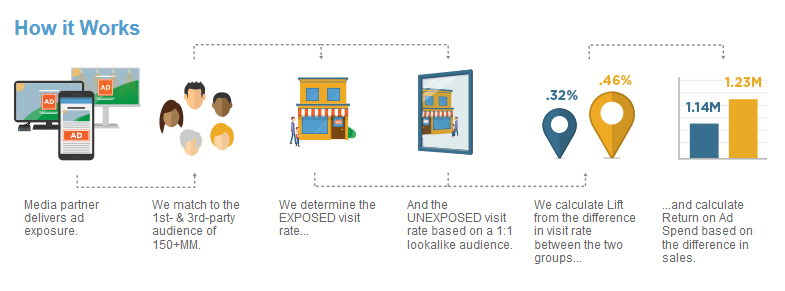Will Location Data be the New Currency of Marketing?
Gone are the days of marketers enthusiastically promoting a 10% off coupon, as today they  need to be more cognitive, and more importantly, they must be more specific, especially while brick-and-mortar earnings are in a blood-bath. Therefore, location-based advertising and marketing technologies have seen a tremendous amount of interest and enhancement in recent years. The idea is measuring ad effectiveness based on foot traffic through a location social app and providing attribution insight based on the action that ads drive at specific locations. In other words, tapping into consumer obsession with mobile devices to trigger local offline conversions through the power of location data.
need to be more cognitive, and more importantly, they must be more specific, especially while brick-and-mortar earnings are in a blood-bath. Therefore, location-based advertising and marketing technologies have seen a tremendous amount of interest and enhancement in recent years. The idea is measuring ad effectiveness based on foot traffic through a location social app and providing attribution insight based on the action that ads drive at specific locations. In other words, tapping into consumer obsession with mobile devices to trigger local offline conversions through the power of location data.
Marketers must have seen the value of it as the surging interest in location-based marketing spend is expected to continuously grow at an annual compound growth rate of 24.6% from almost $10 billion in 2015 to $29.5 billion in 2020, according to BIAKelsey. Additionally, according to the “Global Location Trends Report” launched at SXSW, 75% of 253 global marketers, including Starbucks, BMW, and Coca-Cola, believe that location-based marketing will play a crucial role in their businesses. This obvious interest by marketers naturally drives the big tech players to adopt those capabilities through acquisitions - Apple’s acquisition of Quattro Wireless, Google’s acquisition of AdMob, and AOL’s acquisition of Millennial Media to name a few.
Speaking of acquisitions, one of the most recent ones came from Snapchat maker Snap Inc. as the company acquired Placed, a six-year-old startup that enables advertisers to track real-world purchases and store visits. Over the past 12 months, Placed has measured more than $500 million in media spend to store visits, across thousands of campaigns and hundreds of partners, cementing Placed as the leader in location-based attribution. Last year, the startup also independently conducted a study by measuring the online and offline behavior of Snapchat users to understand what stores have been physically visited by them. Here is how it works:

Placed CEO David Shim says last year the Seattle company measured 1 in 100 adults in the U.S., who share over 2 billion first-party locations every day. This is more first-party locations than generated on all the U.S. ad exchanges combined.
The tech titans are not only making acquisitions but also serious enhancements to location-based advertising and marketing technology. For instance, last month, Google announced a new beta for Google Attribution, a tool that will help advertisers understand whether their online marketing campaigns actually lead to offline sales by measuring the relevant contribution of every single touchpoint along consumers' paths to purchase. From the early testing of the new feature, Google also has found:
- 7 in 10 smartphone owners who make in-store purchases take relevant action on their phone prior to purchase.
- Consumers who click on a Google search ad before visiting a store are 25% more likely to make a purchase.
- They also spend 10% more on average.
In 2010, Apple Inc. co-founder Steve Jobs said: "Mobile advertising really sucks." And he had a point. For a long time, marketers haven’t fully taken advantage of mobile advertising in the way they should have, and they failed a bit at tapping into the reality of the situation that the data coming from a mobile device is the strongest indicator of who someone is and what they like or don't like. The main reason was that they had seen mobile advertising like traditional advertising so it took some time to go beyond the banner ads displayed on the gaming app. However, today, the technology started catching up and marketers got more informed on how to utilize the intersection of the physical and the digital by forming the connective tissue tying these elements together. To that point, I would like to share some of the examples where I think, marketers nailed it.
Earlier last month, my co-worker Laura Myers and I were invited to attend SitefinitySummit 2017 as media, which took place in downtown Boston, with over 150 partners and customers. During a keynote speech given by Loren Jarrett, Chief Marketing Officer at Progress, Duke Bobber, Manager of Digital at Green Bay Packers, took the stage and explained how The Green Bay Packers, a professional American football team based in Green Bay, Wisconsin, utilizes mobile differently to extend the reach of the game beyond the stadium and engage more with their thriving fan base. To us, the most interesting use case was that their mobile site includes a comprehensive directory of official Packers bars and restaurants throughout the United States, tools for fans to connect with each other, and original content about unique Packers fans and bars. So their fans can watch Packers game with their fellow fans in a friendly and fun environment. That way, the organization takes advantage of the social basis of human behavior and accomplishes its goal of expanding its fan base as well as owning more data about them, which might help the marketing department create marketing campaigns based on location in the future.
Location-based marketing is now facing similar challenges as personalized marketing, and the challenge for marketers today is to construct an environment of trust that maintains a level of personalization. Even though marketers are still in the experimental stage when it comes to making effective use of location-based marketing, there are some ground rules that they should be extremely careful about, and the golden rule is “don’t be creepy!” With mobile marketing, it is important to understand that your business is wading into the intimate world of your consumers’ personal life. So while you are tailoring digital experiences based on your audience’s locations and interests, it is critical not to transgress some unwritten social rules. To achieve that, the content you convey into their intimate life should be truly relevant and more importantly, valuable for that audience. In the end of that interaction, your customer should be grateful for receiving that information.
"The one thing people regularly state as 'creepy' online is when an advert follows them around the internet. These plans appear to extend 'creepy' into the physical world," said Renate Samson from Big Brother Watch to BBC and added: "If people want to avoid having their shopping habits monitored on the high street by Google, by shops or by banks they should restrict the amount of data they hand over. Companies track and monitor in order to advertise to us. If we don't want them to do that, take control; don't give your email address for a digital receipt, check the terms and conditions, avoid using loyalty cards and where possible choose to pay with cash."

To me, the way Nivea injected the location-based technology into its marketing campaign of a seasonal product, Nivea Sun Kids, is a great demonstration of how a brand can brilliantly be subtle while creating a great value for its consumers which directly relates to their current location. What the personal care brand did was addressing one of parents’ biggest concerns during the summer time. The main objective was retaining new customers. The aspect of the brand identity that Nivea wanted to fortify was “protection”. To achieve all these together, the brand produced an adjustable bracelet that can then be strapped around a child’s arm. It wasn’t a regular bracelet, as it was a bracelet printed on humidity-resistant paper with a sensor, so parents could download an app where they can activate the sensor by scanning and then they received alerts on their phones when children strayed beyond a safe range based on the parameters the parent set, to which his or her child is allowed to travel. If you are a visual person like me, here’s a brief video that explains how it works:
My POV
Now that the technology has gained steam, organizations can’t afford to ignore the power of location based data as it basically gives marketers a handle on compiling the consumer behavior with location. Regardless of what is trending, I always believe that every brand should maintain its own identity and its unique way of communicating with its audience. Therefore, say, it is too creepy to target your audience with notifications when they are at a specific place, you don’t need to pass on utilizing this technology as it still lights up the customer journey by drawing the pattern and relation, say, between their visits and an ad previously seen. With the combination of other insights, the location-based data help businesses with better tailor ad exposure, and optimize channel spend, site selection, and inventory planning.
Additionally, if you want to engage with your consumers when they are at a certain location, then you should provide them with a conspicuous value. After all, an utterly interactive world where the line between physical and digital have incorporated is the future of marketing.

Venus Tamturk
Venus is the Media Reporter for CMS-Connected, with one of her tasks to write thorough articles by creating the most up-to-date and engaging content using B2B digital marketing. She enjoys increasing brand equity and conversion through the strategic use of social media channels and integrated media marketing plans.